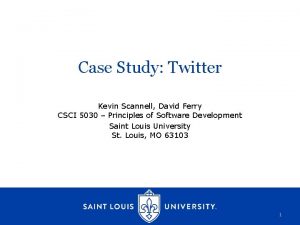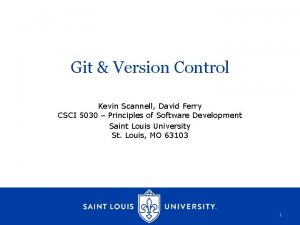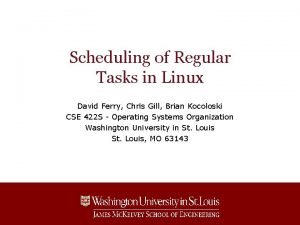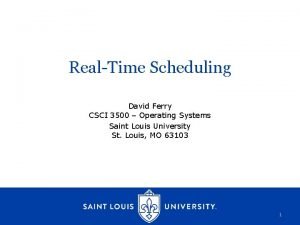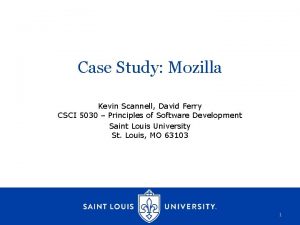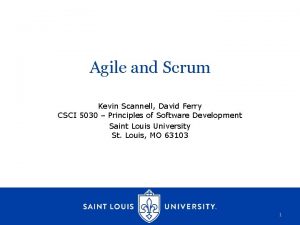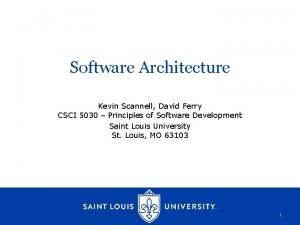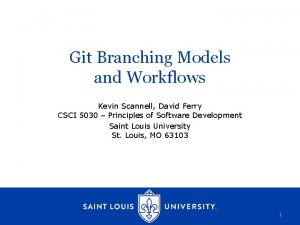Case Study Twitter Kevin Scannell David Ferry CSCI




















- Slides: 20

Case Study: Twitter Kevin Scannell, David Ferry CSCI 5030 – Principles of Software Development Saint Louis University St. Louis, MO 63103 1

Twitter • Created in 2006 by Jack Dorsey (from St. Louis!) • Major shipper of open source software (200+ projects) • “Innovator’s Patent Agreement” – company has promised to only use patents defensively • 500 million tweets per day – Average rate of ~5, 700 tweets per second – Peak reported rate of 143, 199 tweets per second https: //blog. twitter. com/2013/new-tweets-per-second-record-and-how – Critical to a company that wants to be a real-time meeting place for world events CSCI 5030 – Principles of Software Development 2

Big Data / Big Infrastructure Company Where is the value in a company like Twitter? • Users (user data => ad dollars) • Engineering infrastructure What would you need to build a Twitter clone? • Database • Web server • Network programming • Application logic The basic components are not that complicated… CSCI 5030 – Principles of Software Development 3

The idea is simple, the scale is hard Scaling Twitter with Open Source Chris Aniszczyk CSCI 5030 – Principles of Software Development 4

Data Scale at Twitter 1 tweet ~ 200 bytes Is that a lot? • 500 million new tweets => writes 100 GB/day • 350 billion tweets served => reads 70 TB/day • 4 million tweets per sec. served => 800 MB/sec But also in the context of: • Followers, #hashtags, @mentions, lists, and direct messages (DMs) CSCI 5030 – Principles of Software Development 5

Early Architecture • Monolithic application • Written in Ruby on Rails • A highly customized but general purpose “web stack” that you get with a framework • Business logic mixed into a full stack application Scaling Twitter with Open Source Chris Aniszczyk CSCI 5030 – Principles of Software Development 6

Monorail Architecture Problems • Performance – Storage layer bottlenecks – Single threaded/poor concurrency – Single My. SQL storage system couldn’t keep up • Brittle – – All software components part of the same runtime E. g. Japanese translation error brought down entire site Failure “blast radius” is infinite Large data centers reduce mean time between hardware failures to hours, not weeks or months • Hard to modify – – Hundreds of developers working on the same codebase Merge conflict chaos with hundreds of feature branches Lack of ownership over functionality Tight coupling between services CSCI 5030 – Principles of Software Development 7

Monorail Pushed to the Limit Scaling Twitter with Open Source Chris Aniszczyk • Monorail was a single-threaded program with host-level duplication • Peak performance was 200 -300 requests/sec/host • Reconsider the growth curve from before and the linear nature of improvement from throwing hardware at a problem • You want to be at 4 million requests/sec average • What is the peak-case here? • “Optimization corner” – team started to trade off readability and flexibility for performance CSCI 5030 – Principles of Software Development 8

Intuition: Service Oriented Architecture Twitter had grown beyond a single web stack • Separate services into their own components Desires: • Site speed/performance • Isolate responsibilities into components • Isolate failures / improve reliability • Improve developer productivity – As expensive as machines are, people are worse – Clear ownership of services and features – Components were a mixed bag – intra-team productivity improved, cross cutting inter-team work got slower CSCI 5030 – Principles of Software Development 9

Decomposing Monorail carved into a layered architecture based on technical concerns and business groups/objectives within each layer • Routing Layer • Presentation Layer – Desktop web interface – API interface – Search, other public-facing features • Business Logic Layer (separation based on core business nouns) – – – Tweet service User service Social Graph service Timeline service Direct Message Service • Everything is connected via remote procedure call (RPC) CSCI 5030 – Principles of Software Development 10

Modern Twitter Scaling Twitter with Open Source Chris Aniszczyk CSCI 5030 – Principles of Software Development 11

Decomposition Challenges You’re asked to componentize part of a monolithic application… what do you do? Copy-paste! Except now your architecture is: • Distributed • Networked • Many function calls are now RPC …and most of your engineers haven’t done that before. Each team handles problems in slightly different ways: • Error handling/network issues/retrying • Load balancing • Service discovery • Stats collection and distributed tracing CSCI 5030 – Principles of Software Development 12

Finagle Twitter writes their own RPC system (open source) • All RPC calls are implemented as future = make_remote_call( service ); //returns immediately //Do other work result = get_result( future ); • All RPC calls are async/non-blocking • Naturally forces very high level of concurrency • Small number of threads can handle a lot of requests Standard solution for service discovery, error handling, load balancing, system visibility, etc. CSCI 5030 – Principles of Software Development 13

Leveraging Concurrency Tweet Service Client Synchronous Path Store Tweet • • • Durable queue of deferred RPC Deliver Tweet Storing tweets is handled synchronously so that service can return success to the client, but making the whole process synchronous would be too heavyweight (suppose if you have millions of followers) Handling delivery of those tweets can be deferred Delivery actions placed in a durable queue that survives crashes Delivery actions are idempotent- retries do not cause error Client submits tweets with low latency, and if they get an OK response then delivery is guaranteed- or even be farmed out to different services CSCI 5030 – Principles of Software Development 14

Collection of Hosts => Datacenter • Static partitioning is brittle • Manual oversight is slow • Scaling issues cause load imbalance • Failures require human intervention Scaling Twitter with Open Source Chris Aniszczyk CSCI 5030 – Principles of Software Development 15

Mesos Datacenter utilization now a problem – With monorail each host just ran as many copies of the monolithic application as it could – New architecture- how do you determine which components get what resources? – Static partitioning is inefficient, and handles scaling or failure poorly Mesos is an open source operating system for a data center, so engineers focus on resources and workload while Mesos allocates tasks to hardware – Each datacenter is now just another computing resource that you can run applications on CSCI 5030 – Principles of Software Development 16

Results Many other things could be said architecturally, but we have to stop somewhere Technical team hoped that each hardware host could handle 10 x as many requests • Started with 200 -300 requests/sec per host • Achieved 10 K-20 K requests/sec per host • Better architecture led to 100 x better performance with the same hardware CSCI 5030 – Principles of Software Development 17

Latency Improvement • Average case latency improved • Some of the biggest gains in the long tail distribution Scaling Twitter with Open Source Chris Aniszczyk CSCI 5030 – Principles of Software Development 18

Reliability Improvement • Reliability improved, even better than when they had almost no traffic Scaling Twitter with Open Source Chris Aniszczyk CSCI 5030 – Principles of Software Development 19

Lessons Learned The software architecture did many things: • Separated business logic from technical challenges • Focused efforts of developers and clarified responsibility • Provided a concurrency-heavy programming model – Allowed much higher throughput • Minimized the impact of software/hardware failures CSCI 5030 – Principles of Software Development 20
 Kevin scannell
Kevin scannell David scannell qc
David scannell qc Case of murder poem
Case of murder poem Facts about vernon scannell
Facts about vernon scannell David ferry slu
David ferry slu David ferry slu
David ferry slu David ferry
David ferry Necesscity
Necesscity Best case worst case average case
Best case worst case average case Fbi virtual case file case study
Fbi virtual case file case study Facebook osint
Facebook osint Nettles poem meaning
Nettles poem meaning The poem nettles
The poem nettles Dr. nancy j. scannell
Dr. nancy j. scannell Cian scannell
Cian scannell Author study kevin henkes
Author study kevin henkes Kevin henkes biography
Kevin henkes biography Heards ferry eagle alliance
Heards ferry eagle alliance Baragoo
Baragoo Ferry hill place
Ferry hill place Harpers ferry raid apush
Harpers ferry raid apush
